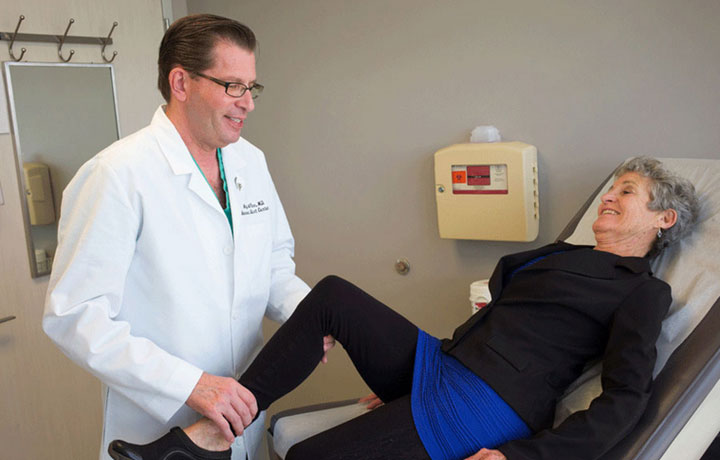Call it fate, a serendipitous encounter or divine intervention. Awaking from an anesthetic state in Weiss Memorial Hospital’s post-op recovery room, two friends who share a love for yoga and hadn’t seen each other in years discovered they each had undergone surgery on the same day in the same place.
“What are the odds that we’d have surgery in the same hospital by the same surgeon on the same day, back to back,” said Sharon Steffensen, 73, of Chicago, who had a total hip replacement on May 3, 2016, at Weiss Memorial Hospital, with orthopedic specialist Henry Finn, MD. She had her other hip replaced by Dr. Finn in March 2015.
Her friend, Hannah Hedrick, 77, of Hawaii had just undergone a hip revision. After 20 years, her original hip implant bearing had started to wear out in her hip socket, causing pain.
“We needed to replace the lining of Ms. Hedrick’s hip socket and graft her pelvic bone,” said Dr. Finn, medical director of the Chicago Center for Orthopedics at Weiss Memorial Hospital, chairman of surgery at Weiss and professor of Orthopaedic Surgery at the University of Chicago. “The part of the implant was deteriorating and eating away at the bone like a cavity in a tooth.”

Dr. Finn further explains about the complex hip revision procedure, “Her hip would have gotten worse had she waited any longer for surgery.”
Hedrick now is recovering well. Dr. Finn says “mind over matter” can benefit many patients recovering from surgery. “People who think positively always do better. Endorphins in the brain created through regular exercise lead to the right mindset going into surgery and recovering from it. Being physically fit also makes a difference. It’s really a combination of the two – a healthy mind and body – that can result in recovering quicker.”
Hedrick and Steffensen personally attribute their good health to years of practicing yoga – the ancient Indian art of exercise, breathing and meditation. Both are yoga instructors, and Steffensen is founder of Yoga Chicago, a magazine in which she has featured Hedrick numerous times.
“You need to keep breathing deeply and moving,” said Hedrick, who flew more than 4,100 miles to Chicago from Hawaii for the surgery. She moved to Mountain View on the big island of Hawaii in 2000, four years after her first hip replacement at Weiss, to care for her elderly mother. She never moved back to the mainland after her mother’s death seven months later, but she did return to Weiss for a joint replacement in her other hip in 2003. Despite the distance, she has stayed in touch with her yoga community over the years via email and at industry conferences.
Hedrick informed her friends of her impending hip revision surgery in a group email. “I assumed she’d be getting the surgery done in Hawaii where she lived,” Steffensen explained. She then also was glad to hear she was in the same physical therapy group the next day with Hedrick at Weiss.
Hedrick had referred Steffensen to Dr. Finn at Weiss for her hip replacements last year.
Studies have shown yoga helps people with arthritis improve physical and psychological symptoms. According to Arthritis.org, research reveals regularly practicing yoga can ease joint pain and improve joint flexibility and function, mainly through the reduction of inflammation, the main cause of arthritis pain. One study states inflammation is better controlled by the stress-reducing effects of yoga, which promotes better sleep.
“I have observed this to be true, but there is no science to prove the impact of yoga on joint pain and arthritis flare-ups,” Dr. Finn added.
Hedrick and Steffensen both personally believe the muscle-strengthening benefits of yoga and movement techniques eased arthritic pain. They say they felt their strong core muscles helped to support their joints as they lost cartilage and their hip sockets became bone on bone. The two women also believe a strong core is helping in their recovery process with balance, range of motion and giving their new hip the support it needs.
“They are a testament to the benefits of staying active well into your retirement years, and knowing when to seek surgery for joint pain,” Dr. Finn said.
Regarding limits to movement with the new hip, Dr. Finn advises some restrictions only in the first six weeks of recovery.
At a two-week follow-up appointment, Steffensen noted her hip replacement healing a bit slower than her other one last year. Medical professionals say every hip is different and it is best not to compare. “This one needs a little more tender loving care,” Steffensen said. Still she is applying the tools of yoga—deep breathing, mindfulness and gentleness.
Although Steffensen and Hedrick will soon be going their separate ways again, they plan to stay active and keep the yoga “movement” strong among their peers and younger generation well into their 80’s and 90’s.
Hedrick already has developed a 45-minute practice expanding on the post-surgery physical therapy exercises, incorporating back, abdomen and arm strengthening movements. “I will continue to adapt my postures, and move anything I can, any which way I can, for as long as I can.”
